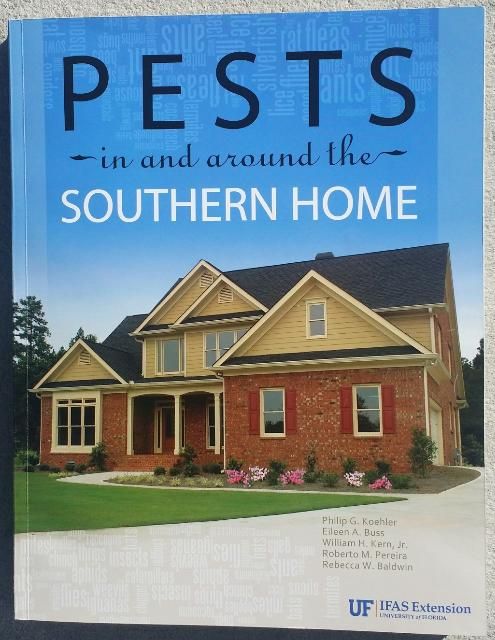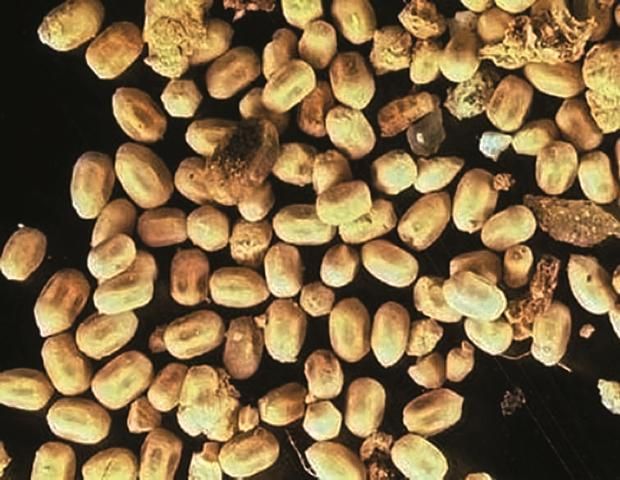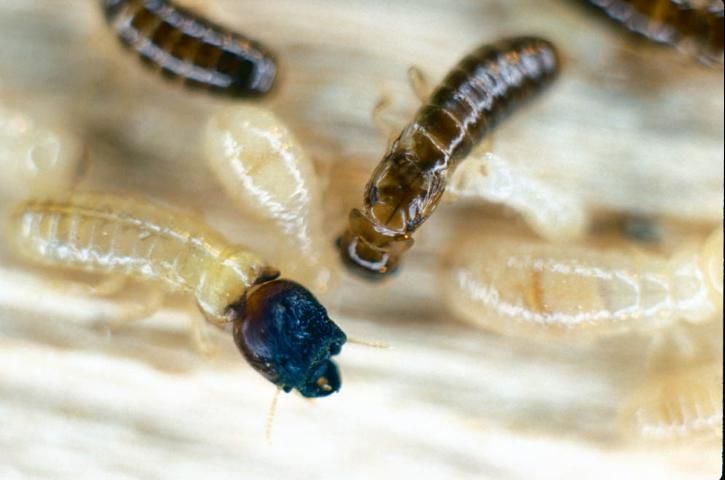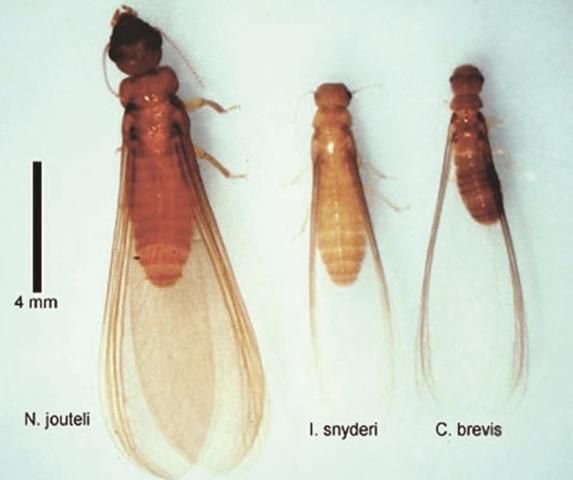
Credits: UF/IFAS
Termites responsible for damage in Florida include drywood termites, dampwood termites, and subterranean termites. In this article, you will find helpful information focusing on drywood and dampwood termites. These termites differ from subterranean termites in that they form their nests and live inside their food source as opposed to nesting underground. Control and preventative measures can easily be taken to avoid an infestation. Information on subterranean termites can be found in the chapter, Subterranean Termites.
Termites are considered to be social insects, meaning they live together in societies called colonies. These colonies consist of soldiers for defense, reproductives, nymphs, and immatures known as pseudergates, or "false workers," that perform most of the work of the colony.
Knowing the termite species you are dealing with is important because treatment measures are different depending on the species. These treatments can differ in cost, application method, and the product used.
Drywood termites typically infest sound or nondecayed wood in older homes. Places they can be found in a home include wood flooring, attics, wood frames, fascia boards, window sills, doors, and furniture. Drywood termites survive best at 60°F (16°C) but have been reported in temperatures of 110°F (43°C). Initially, winged termites known as swarmers or alates will enter cracks and openings in wood to start new colonies. These termites have evolved to be able to survive in environmental extremes. This is important because, unlike subterranean termites, drywood termites cannot retreat to the soil when conditions are unfavorable. They have adapted very well to dry environments by having a more impermeable cuticle to retain body moisture. Also, they are more efficient at resorbing water from their excrement, or feces—a process that causes its characteristic pellet shape.
Dampwood termites infest wood with high moisture content. They do not need soil contact in order to sustain themselves, but are commonly found in wood with ground contact. They are commonly found infesting damp or decaying wood, logs, stumps, and dead trees, but will commonly attack structures exposed to moist soil and high humidity. Although dampwood termites can cause significant damage, especially in association with decaying fungi, they are considered to be the least economically destructive pest.
Signs of Infestation
Drywood Termites
A good way to know if there is a drywood termite infestation is from their six-sided fecal pellets, known as frass (Figure 1). These fecal pellets are removed from drywood termite nests through small "kick-out holes," which are about 1 to 2 mm in diameter. These are normally found in mounds and have been described to look like sawdust or coffee grounds. These are usually light tan to almost black, but have no relation to the color of the wood the termites are feeding on. If rolled between your fingers, you will notice a gritty texture of the pellets, this is a way many pest control operators identify drywood termite feces.

If fecal pellets are difficult to identify, surface blistering or warping is a good sign of an advanced infestation. Blistering occurs many times because of the termites tunneling right under the outer surface of the wood, which gives a blistered appearance. When this is visible, it is necessary to open the wood to be sure it is a drywood termite infestation you are dealing with. Tapping the wood with the end of a screwdriver or similar tool and listening for a hollow, papery, rustling sound can be used to detect an infestation. Because drywood termite colonies are smaller than subterranean termites, they are usually found in localized areas and not as spread out. Multiple colonies may be found infesting a single structure, so it is important to check the entire structure even after one colony has been detected.
Dampwood Termites
Finding dampwood termite infestations can be a little tricky because there is little visual external evidence of their presence; they do not produce mud tubes or create visible open holes in the wood. They hide very well in the wood to prevent themselves from drying out, plugging holes with fecal material. Tapping wood that sounds hollow or feels soft is a good sign of a dampwood termite infestation. Different wood will show a different appearance of damage. In sound wood, dampwood termites will eat the softer spring woods, like subterranean termites. In decayed wood, they will form galleries and tunnels that extend across the grain, such as damage by drywood termites. Fecal pellets may also be found in infested structures and will be found stuck to the sides of the galleries, usually forming clumps of feces. However, if conditions are dry, dampwood termite frass will be collected at the bottom of galleries, or outside of the infested material. While looking for a dampwood termite infestation, it is important to be aware of sources of excess moisture and other conditions that may lead to wood decay.
When swarmers of drywood and dampwood termites are visible, it is a good indication of an existing infestation. Many times, homeowners will find only the wings of the termites but not the bodies. This is because swarmers will shed their wings after short flights. Termites are typically weak fliers and will not travel far—usually only a few feet before settling down, unless wind currents are present to help them travel farther. Swarmers are often attracted to light and consequently found around windowsills, floors and spider webs. Because time of swarming is different for various species of termites, pretreatment is key to avoiding an infestation.
Description of Drywood and Dampwood Termites in Florida
Drywood Termites
The West Indian drywood termite is one of the most widespread of all termite species and very dominant in the southeastern United States. Fecal pellets of this species tend to be smaller than typical drywood termite feces, so they are often referred to as “powderpost termites”. Unlike other drywood termites species, the West Indian drywood termite is prone to attack small furniture such as table legs and picture frames, and so it is easily transported from one place to another. Swarmers, or alates, are usually found between April and July. They are medium brown and typically about 3/8 inch long, with translucent wings. Soldiers of this termite are very easily identified by their head, which looks much like a burnt match (Figure 2).

Credit: University of Florida
The southeastern drywood termite is the most widely distributed in the eastern United States. Along with the West Indian drywood termite it is also a very dominant species in the southeastern United States, but colonies are typically larger for the southeastern termites. Swarmers of this species are 7/16 inch (11 mm) long and usually yellow to yellowish-brown, with translucent wings. Swarms are usually found from May to November.
The western drywood termite is found in many parts of the South, although it is a non-native termite. In the western United States this species is the major drywood termite pest, swarming between the end of August to November.
Dampwood termite swarmers (average length ½ inch, or 14 mm) are generally larger than subterranean and drywood termite swarmers [average length about 1/3 inch (10 mm), or less (Figure 3)]. Soldiers are about ¾ inch (19 mm) long with the head and jaws comprising about one third of their length. They have a reddish brown to blackish head and a cream body. Nymphs are about ½ inch (13 mm), long.

Neotermes castaneus is the largest dampwood termite, with wings longer than ½ inch, or 16 mm. In the southeastern United States it is not an economically important pest and can be found in living trees. N. castaneus swarms during August through early December. Neotermes jouteli infests drier wood compared to other dampwood species. It is known only as an incidental pest in structures with excessive moisture problems. N. jouteli swarms from March to early June, then again in August to early November. Neotermes luykxi is also an incidental pest in structures. N. luykxi swarms from the end of June to early October.
When specimens are submitted for identification by experts, it is very important to submit swarmers (Figure 4) because these specimens allow identification to the species level. If nonreproductives are collected, it is always better to include soldiers, rather than just workers, since these are very hard to identify. The best way to preserve samples for identification is in rubbing alcohol so they do not dry out and lose their normal shape.

Dampwood and Drywood Termite Control
Dampwood Termites
Because dampwood termites survive only in constant contact with wood with elevated moisture content, control of these pests may rely primarily on the elimination of moisture sources such as leaking pipes and roofs. Soil treatments may be effective if the wood is in contact with soil.
Drywood Termites
Drywood termites present a different control problem because they live within wood that is fairly dry and usually do not reach structures via the soil. Prevention of infestations is the most reliable way of limiting drywood damage. Methods used in the prevention of subterranean termites such as soil treatment with termiticides do not work with drywood termites.
Prevention
The objective of preventive measures is basically to avoid the initial establishment of incipient termite colonies by swarmers. Because these insects usually gain entry into structures through cracks, joints, vents, and other openings, closing these points of entry represents the best way to prevent infestations from getting established. Screening (20 mesh) should be used to cover vents and other larger openings. Small cracks and joints should be sealed with caulk or other materials. Wood surfaces should be painted to prevent decay and cracking as well as direct termite infestations.
Another important preventive measure is to make wood elements in the structure undesirable to the termites. Pressure-treated wood will not be infested by drywood termites and should be used whenever possible. However, cost and other considerations may make the use of pressure-treated wood unviable. Other materials can be used to treat the wood after the structure has been built. Both borates and silica gel can be used in sprays or dusts to form a protective coating on the wood.
The use of wood that is naturally resistant to termite infestation is a costly but effective preventive measure. Heartwood of redwood, bald cypress, mahogany, and Spanish cedar are some of the woods that can be used. However, as these woods age when exposed to the elements, they lose the properties that make them termite-resistant, and drywood infestations may be initiated. Maintaining proper sealing of the wood will cause the wood to age at a slower pace and prevent termite infestations for a longer period of time.
Inspection
An inspection is an important step both in the prevention of damaging populations of drywood termites and in the elimination of existing infestations. Before control can be properly applied, a thorough inspection must be performed, both to identify the extent of the infestation and allow proper planning of the control operation.
The most common sign of drywood termite infestation is piles of fecal pellets that push out of the galleries via the "kick-out" holes. The dry, barrel-shaped fecal pellets can vary in color but look like coarse sand grains. They accumulate on horizontal surfaces below the kick-out holes. These holes are most commonly found in joints and cracks in the infested woodwork. When fecal pellets are pushed out of the termite galleries they fall onto any surface below. Depending on the distance between the hole and the surface, the pellets may accumulate in neatly formed piles if falling a short distance, or scatter over a larger area if falling from greater height.
Whether pellets are found or not, wooden elements in a structure can be inspected by tapping a screwdriver or another hard instrument against the wood. Termite-damaged wood will produce a hollow sound. In severely damaged wood, the tapping instrument will go through the wood and may expose galleries. Drywood termites may dig galleries right below the wood surface, leaving a paper-thin layer that breaks very easily during inspection. The fecal pellets can also be seen throughout the galleries. However, unlike subterranean termites, no mud tubes or dirt will be found inside drywood termite galleries. The paint layer in damaged wood may look blistered due to the gallery excavations by the termites.
Drywood termites commonly infest the upper portion and attic in structures, unlike subterranean termites, which are usually found closer to the ground. Thus, inspection of attics is very important. Exposed wood in these areas must be tapped as described above, and the inspector must look for fecal pellet accumulations to determine location and extent of infestations.
Once signs of infestations are seen, the adjacent area must be inspected to determine how far the infestation extends. Determining the infestation area is an essential step in the control because small infestations can be controlled easily with local treatments, but extensive infestations must be dealt with in a different manner.
There are several other methods used for inspections. Trained dogs, methane detectors, stethoscopes, and moisture meters have limited applications in drywood termites. Acoustic and microwave detectors are better at detecting infestations but also present some difficulties.
Ultimately, part of walls and other construction elements may need to be removed in order to verify the extent of infestation. Although exposed wood elements can be inspected directly, wood framing behind drywalls and other construction materials must be exposed before the extent of infestation can be verified.
Control
The extent of damage is the most important consideration in determining the method of control to be used. While small infestations may be remediated with simple and inexpensive methods, the use of inadequate methods may complicate and even increase larger infestations.
For small infestations, such as when a door frame, window frame, furniture, or limited portion of wooden elements are infested, low cost, convenient methods can be used. Termiticide injections into the termite galleries will directly expose some of the individuals in the colony to the pesticide and others indirectly through the termite grooming behavior. Dusts, liquids, sprays and foams can be used, but products must be nonrepellent so termite contact with the product is maximized. If repellent formulations are used, termites avoid contact with the product and do not acquire a lethal dose. Special attention must be paid to getting complete exposure of the colony to the products. Otherwise, pockets of survivors may escape control and reestablish an infestation.
Several nonchemical methods have been tried and are available for treatment of localized infestations. The simplest method is wood replacement. If the infestation is known to be localized in a wood element that can be removed and replaced, that should be done. Special attention must be paid when doing the inspection so that all infested material is completely removed and properly discarded, in order to prevent reinfestation.
Heat may be applied to localized infestations, but measures that prevent the termites from escaping the treated area into adjacent areas are very important. Cold, especially in the form of liquid nitrogen, can be injected directly into termite galleries in order to freeze the insects. Temperatures around 20°F (-7°C) must be reached so that termites can be killed with very short exposure, and precautions must be taken to prevent operator asphyxiation and burns.
Electrocution and the use of microwaves that cause the termites to die by overheating are also used in the elimination of localized infestations. Both methods are limited in penetration and area affected, so thorough applications are needed. In the case of electrocution, copper wires may need to be inserted into the galleries (drill-and-pin applications) in order to reach the termites.
Few control methods are available to treat larger drywood termite infestations, which require whole-structure treatments. The use of fumigant pesticides or heat is the only treatments for control of drywood termites and some other insects, such as bedbugs, in whole-structure treatments.
Fumigation is widely used for control of whole-structure termite infestations. Although it is very efficient when correctly applied, fumigation leaves no residue, and reinfestations can occur as long as no other preventive measures are taken to keep drywood termites from reinvading the structure. One of the greatest drawbacks of fumigation is that the structure occupants, in either a business or residence, must vacate the premises for a minimum of several hours to a few days. Currently, sulfuryl fluoride is the most common fumigant pesticide used, and it requires shorter exposure times, usually six to 18 hours, to kill termites. In the past, the use of methyl bromide would require much longer exposure times—sometimes days.
Fumigation is a very specialized process that requires expert attention. It can be very expensive because of the cost of labor, special equipment, and material involved in a treatment. Drilling holes into the walls may facilitate the penetration of the fumigant into locations infested with termites. Because of the poisonous nature of the fumigant gas, treated structures must be sealed, usually by using large tarps to completely cover the whole structure. After the treatment is completed, the structure must be opened, and the levels of the fumigant must be monitored until they are low enough to allow residents and other occupants to reenter the structure.
Another option for whole-structure treatment is the use of heat. Like fumigation, no residual is left after the treatment is finished, and reinfestations are possible as soon as the building is reopened. A patent-protected system has been licensed to several companies for application in the control of termites and other insects. Heat can penetrate certain materials faster than fumigant gases. Temperatures around 50°C (120°F) are sufficient to kill termites. However, temperatures in the treated structure are raised to 60–65°C (140–150°F) to ensure heat penetration into all the structure, without damage to materials and equipment in the treated structure.
Although tarping is not necessary for whole-structure heat treatment because no poisonous gas is used, tarping may be done in order to better contain the heat and allow better treatment of outside walls by containing heated air on both sides of these walls. Before heat treatments are done, heat-sensitive materials such as anything that would melt or be damaged at the temperatures reached during treatment, must be removed from the structure. After the heat treatment is done, no special precaution is necessary before reentry into the building. Heat treatments may be accomplished in shorter time than fumigation as long as the proper equipment is available.